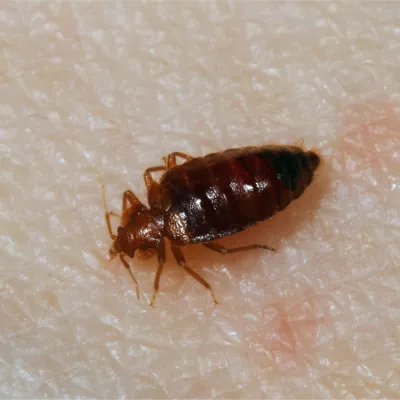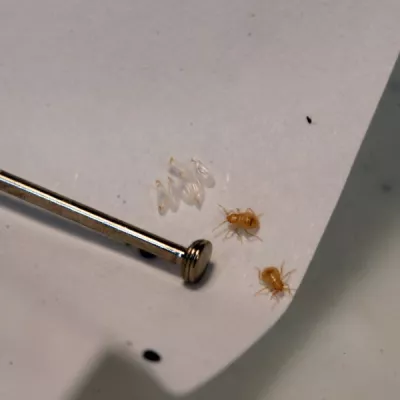-
Residential services
Residential services
Most popular package$102/moPest + termite planOur specialized termite treatments help minimize their presence, while our core management services keeps up to 20 other pests in check.Find your plan - Service areas
- About
- Special offers
- Contact
(877) 372-9696
Bed bugs.
Small, elusive, and expert hitchhikers, bed bugs can quickly turn restful nights into restless ones. Discover how to spot the signs, understand their behavior, and explore effective treatment options.
(877) 372-9696
or request your free quote
"*" indicates required fields
Bed bugs are notorious parasitic insects that feed on us where we should feel most comfortable. Nearly eradicated in the mid-20th century, they’ve made a significant comeback across the country, including in North Carolina. Their health risks, rapid reproduction and ability to hide in small spaces make them one of the most problematic pests.
Identifying bed bugs: Appearance and lifecycle.


Adult bed bugs are small, flat insects, roughly the size of an apple seed, measuring 3/16 to 1/4 inch in length when fully grown. Between feedings on the blood of hosts, they are typically brown, flat and oval-shaped. After feedings, they become reddish-brown and elongated.
The primary difference between male and female bed bugs is that females can lay 3 to 5 pearl-white eggs daily, totaling up to around 300 eggs in their average 4-12 month lifetime. Bed bug eggs hatch in about 6 to 10 days, producing translucent or yellowish-white nymphs. Nymphs then reach adulthood after five “blood meals,” or full feedings on hosts, typically over 25 to 50 days.
How bed bugs feed.
Bed bugs are nocturnal and primarily feed at night on sleeping hosts. They use their piercing mouthparts to consume blood, with a typical feeding session lasting 5 to 10 minutes. Adults usually feed every 5 to 10 days. Unfortunately, they can survive up to a year without feeding, especially in mildly warm temperatures and moderate humidity.
Signs and health risks of bed bug infestations.
If you're dealing with a bed bug infestation in a bedroom (though they can occur elsewhere), you may notice these signs in addition to actual bites:
- Blood stains on your bed resembling rust spots
- A strong, musty odor coming from your mattress
- Small brown ovals (shed skins) on your sheets
Bed bug bites can cause itchy red welts, in zigzagging lines or clusters, along with rashes and hives. In rare cases, severe allergic reactions—including anaphylactic shock—may occur. Beyond physical discomfort, their presence often triggers anxiety, stress and a fear of sleeping.
Terminix Triad provides specialized bed bug services because we understand the importance of eliminating these pests so you can live or work in comfort.
How do you get bed bugs?
Increased travel is a leading cause of bed bug infestations, which is why they're often found in hotels. As people move from place to place, bed bugs can easily hitch a ride on luggage, clothing or other personal belongings, increasing the chances of them spreading to new locations.
Common hiding places for bed bugs.
Bed bug infestations are often found in:
- Bedrooms (mattresses, bedding, box springs): Seams, piping, fold, headboards, footboards—they’re all perfect for bed bugs to stay close to hosts.
- Structural areas: Cracks, crevices, wall hangings and corners of ceilings and walls can also act as hiding spots.
- Other hiding spots: Electrical outlets, carpets, clothing and luggage can further hide these pests.
Open Treatment configuration options
Treatment
DIY prevention methods can be challenging, as low-level infestations may be difficult to detect, and bed bugs resist many over-the-counter insecticides. While steps like decluttering, cleaning, and special mattress protectors can help, bed bugs are small and elusive, making effective treatment difficult.
The only surefire way to eliminate bed bugs is through expert pest control. Terminix Triad can fully treat a home or business in just one visit, effectively eliminating all bed bugs—including unhatched eggs. Our process includes:
Utilizing multiple treatment methods to interrupt their breeding cycle and fully eliminate them.
Performing a detailed inspection to assess the infestation.
Discussing our findings and treatment strategy with you.
Creating a targeted treatment plan to eradicate every last bed bug.
(877) 372-9696
or request your free quote
"*" indicates required fields